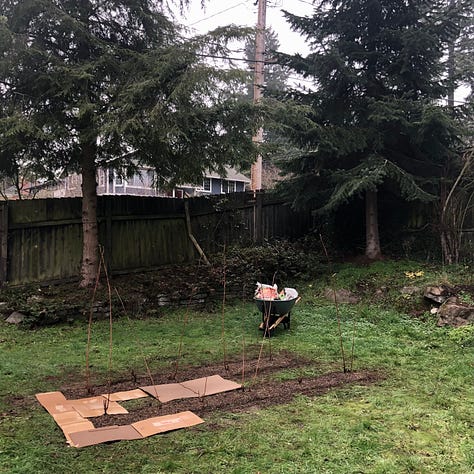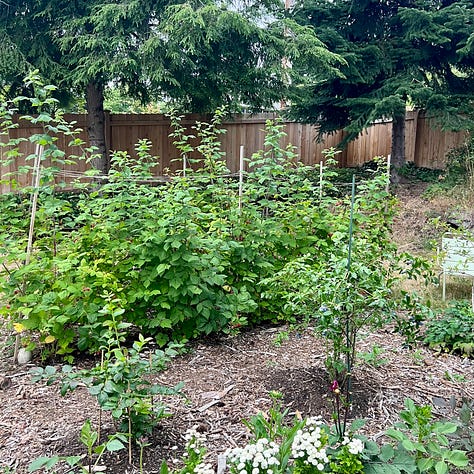My Raspberry Patch & the Joys of Pilfered Plants
In which I acquire raspberry canes under questionable circumstances
In January of 2022, a friend sent me a text. The house across the street from her was getting torn down – and the garden would also be razed. The owners were already gone, but they mentioned in passing that she should dig up anything she wanted from the yard. Now, my friend was designating me as her proxy, and because there were free raspberry canes and blueberry bushes involved, I was happy to accept.
I texted my little brother, 10 years littler to be exact, who happened to be in town. One of the things I appreciate most about my brother is his willingness to say yes to things with absolutely no context. Can a man I just started dating borrow your car to drive from SF to Seattle? “Sure.” Do you want to sneak into a stranger’s yard and dig up some plants to which we have a questionable claim? “Yeah, what time?”
The next morning, my brother and I set off with a shovel, a spade and a few of those orange Home Depot buckets. We didn’t have an address, just an approximate location and the color of the house: teal. We located the house easily but finding the plants themselves proved more difficult. At the time, I’d not been gardening all that long and my plant ID was pretty shaky — even more so when the plants in question HAD NO LEAVES. I also felt some urgency to complete this errand quickly because our presence was immediately noticed by several neighbors.
Walkers struck up conversations, passing cars stopped, reversed, and looked. By the time we found the plants about 10 minutes later, we’d given a fence builder permission to come into the yard to finish the back side of his fence, met at least six of our “new neighbors”, and disappointed all of them. Not only were we not their new neighbors, but we also had no knowledge of the whereabouts of the previous occupants (true), or about fate of the house (false: we knew, it just wasn’t our story to tell).
I realized that rather than admit participation in “upzoning” (a contentious issue in Seattle, and especially in that neighborhood), the house’s occupants had fled, quietly, and presumably in the middle of the night. No one seemed to know anything about what happened to them, and they really wanted us, the people currently digging up the garden, to know.
We didn’t. So we dug faster.
We dug up two mature blueberry bushes and a massively overgrown and neglected 1’ patch of raspberry canes, plopped them in our orange buckets, and took off.
Having escaped the odd microcosm of urban development-debate that was this house, my brother and I and surveyed our plants and our options for their new home. I had previously made grand plans to till up a large section of the backyard lawn, cover it with cardboard, compost, and mulch, and slowly, lovingly, create a home for my berry patch. These plants had arrived unexpectedly, so now I was currently staring at a sad patch of winter grass. Also, it was January, and the time to do anything lovingly whilst outside was at least two months away. The canes would have to planted directly into the grass, before I’d had a chance to improve the soil.
I separated the tangled clump of raspberry canes into no fewer than 10 plants. We unearthed a tiller, borrowed from my neighbor, and got it going long enough to create two (somewhat) parallel trenches. We added compost to the rocky clay soil, put the raspberries in, and hoped for the best.



18 months later, the raspberry patch, despite its questionable origins and less-than-delicate planting, has exploded.
I’m picking cups of raspberries every day. The raspberry runners (which are relentless) have filled in the gaps to create two walls of raspberries. Other raspberry runners have been dug up and transferred to my sister’s garden, where they will inevitably exceed their allotted section of yard just like they have done with mine. My pilfered plants have done their job, and they’ve done it exceedingly well.
A few notes on caring for raspberries:
I got a lot of information about caring for these inherited (stolen?) raspberry plants from Tara Austen Weaver’s wonderful book, Growing Berries and Fruit Trees in the Pacific Northwest.
Raspberries are fairly low maintenance, but they do take some intervention a few times a year. Despite basically throwing the canes into the ground, I have improved my care of these plants over time. I fertilize and add a layer of compost in early spring and cut the fruit producing canes down in late July. I stake and tie up the new runners a couple of times a year, or whenever the rows dip and threaten to tip over.
Raspberry’s tendency to CONSTANTLY put out runners is a doubled edged sword. Yes, you will invest a non-zero amount of time pulling them up in an effort to contain your patch. But, on a positive note: these volunteers can be dug up and replanted and will allow you to share your plants, or, to acquire a thriving raspberry patch without spending a cent on plants.
Also! Also: Raspberry runners are excellent to use for raspberry leaf tea. Use the leaves fresh, or hang the stems upside down to dry, and store the leaves in an airtight container. Raspberry leaf isn’t a very strong flavor on its own, but it makes a gentle, soothing tea — or a great backdrop for blending with stronger flavored herbs. My current favorite blend is raspberry leaf, lemon verbena & chamomile.




Sweet post! I have a raspberry patch with a story, too. Blog post link if you're interested below. Anyway, I give away starts every year, so would have been happy to share with you, but now yours wants to take over the world too. Enjoy! https://pacificnwseasons.blogspot.com/2012/05/northwest-flavors-raspberry-love-mother.html